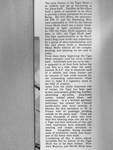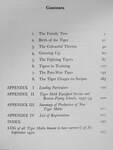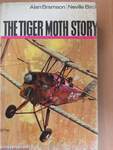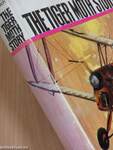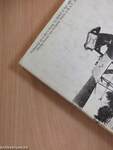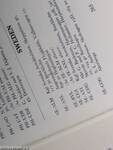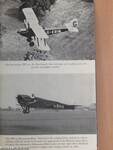1.034.226
kiadvánnyal nyújtjuk Magyarország legnagyobb antikvár könyv-kínálatát

VISSZA
A TETEJÉRE
JAVASLATOKÉszre-
vételek
The Tiger Moth Story
| Kiadó: | Air Review Limited |
|---|---|
| Kiadás helye: | Letchworth |
| Kiadás éve: | |
| Kötés típusa: | Fűzött kemény papírkötés |
| Oldalszám: | 268 oldal |
| Sorozatcím: | |
| Kötetszám: | |
| Nyelv: | Angol |
| Méret: | 21 cm x 14 cm |
| ISBN: | 902853-00-7 |
| Megjegyzés: | Fekete-fehér fotókkal, illusztrációkkal. |
naponta értesítjük a beérkező friss
kiadványokról
naponta értesítjük a beérkező friss
kiadványokról
Fülszöveg
The early history of the Tiger Moth is as unlikely and yet as fascinating as the 'pláne itself. Geoffrey de Havilland built a series of machines in an effort to provide a cheap aeroplane for priváté flying. His first efforts, the unsuccess-ful DH 51 and the Humming Bird, were superseded in 1925 by the famous Cirrus Moth which was a major break-through in light aeroplane design. In 1928 the Gipsy Moth appeared and then, in 1931, the Tiger Moth itself. The final transformation at de Havil-land's Stag Lane works was undertaken by a group of men experimenting with bits and pieces from a dismantled Metál Moth without all the complex drawings and planning we are used to today.
From these shaky beginnings the Tiger Moth emerged—and has never looked back. Admittedly luck was on its side— it appeared in its final form before the Last War at a time when the newly aroused R.A.F. was in desperate need of a reliable and cheap trainer—yet no amount of luck could account for the outstanding... Tovább
Fülszöveg
The early history of the Tiger Moth is as unlikely and yet as fascinating as the 'pláne itself. Geoffrey de Havilland built a series of machines in an effort to provide a cheap aeroplane for priváté flying. His first efforts, the unsuccess-ful DH 51 and the Humming Bird, were superseded in 1925 by the famous Cirrus Moth which was a major break-through in light aeroplane design. In 1928 the Gipsy Moth appeared and then, in 1931, the Tiger Moth itself. The final transformation at de Havil-land's Stag Lane works was undertaken by a group of men experimenting with bits and pieces from a dismantled Metál Moth without all the complex drawings and planning we are used to today.
From these shaky beginnings the Tiger Moth emerged—and has never looked back. Admittedly luck was on its side— it appeared in its final form before the Last War at a time when the newly aroused R.A.F. was in desperate need of a reliable and cheap trainer—yet no amount of luck could account for the outstanding achievements which were to make it a legendary name in the íield of aviation. Apart from the vitally important role of trainer, the Tiger has been used as taxi, crop sprayer, glider tug, bomber, advertising sky-writer, parachutist carrier, coastal patrol f>lane, and ambulance. It is a brilliant aerobatic performer, has crossed the Channel upside-down and, more recently, it became the first aeroplane to fly to Francé with its passenger standing outside on the petrol tank! There are many thousands of pilots who took their first faltering steps into the air in a Tiger and their memories of that and other experiences have endeared this amazing and unique aeroplane to them. Altogether, during fourteen years of production, nearly nine thous-and of the breed were made. Considering all this, it seems almost incredible that no history of the Tiger Moth has so far been written. Now Alan Bramson and Neville Birch have
set this deplorable state of affairs to rights. Besides relating somé amusing störies of the Tiger Moth's exploits in its varied fields of operation, the co-authors have used their enormous knowledge and expérience of the 'pláne to present new information which will surprise many. They end with a vivid recollection of how it feels to be back in the pilot's seat, and to hear again the 'wind in the wires'.
ABOUT THE AUTHORS
Alan Bramson was a war-time flying in-structor, and later a Professional pilot. He has a C.P.L. and has flown more than 100 types of aircraft. Since 1955 he has been a member of the Panel of Examiners which tests Civil flying instructors for the Civil Authority. He is alsó a Liveryman of the Guild of Air Pilots and Air Navigators.
Neville Birch served as a pilot in R.A.F. Transport Command, and is now an examiner for Priváté Pilots1 Licences. He was the founder and is a director of the Warwickshire Aero Club where he was formerly Chief Flying Instructor, and is a Liveryman of the Guild of Air Pilots and Air Navigators.
Both authors have previously collabo-rated in the writing of the official Civil Flying Training Manuals, Flight Briefing for Pilots in four volumes, and of A Guide to Aircraft Ownership.
PUBLISHER'S NOTE
This revised/up-dated (third) edition con-tains 12 extra pages of text, 12 extra pages of photographs and a LOG listing the Registration Nos., owners, date of manufacture—works and/or Service num-ber(s)—where known, »of over 250 Tiger Moths with current C or A's in Septem-ber 1970.
Countries represented are the United Kingdom, Australia, B.elgium, Canada, Denmark, Francé, Italy, Federal Repub-lic of Germany, Finland, Holland, Ice-land, Ireland (Eire), Norway, NeW Zea-land. Portugál, Spain, Sweden, Switzer-land, United States of America . . . and one Tiger Moth in Fiji! Vissza
Témakörök
- Idegennyelv > Idegennyelvű könyvek > Angol > Műszaki
- Idegennyelv > Idegennyelvű könyvek > Angol > Történelem > Európa története > Egyéb
- Történelem > Idegennyelvű > Angol
- Történelem > Legújabb kor > Egyéb
- Történelem > Kontinensek szerint > Európa, európai országok története > Nyugat-Európa > Anglia
- Történelem > Hadtörténet > Fegyverek, fegyvernemek
- Műszaki > Idegennyelv > Angol
- Műszaki > Hadászat, hadtörténet
- Műszaki > Közlekedés > Repülés > Repülők
- Műszaki > Közlekedés > Repülés > Repüléstörténet
- Műszaki > Közlekedés > Repülés > Repülőgépgyártás
- Műszaki
- Műszaki
- Műszaki






